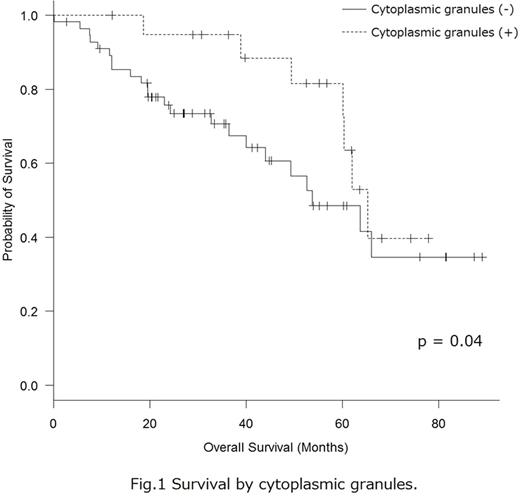Abstract
Background
Multiple myeloma shows various morphological abnormalities such as plasmablastic morphology, cytoplasmic granules, vacuolation, and nuclear atypia. Although plasablastic morphology has been revealed as a poor prognostic factor, little is known about clinical significance of other abnormalities. Therefore we investigated a correlation between morphological abnormalities and clinical outcome.
Methods
Patient Selection
A total of 76 multiple myeloma patients who hospitalized in National Center for Global Health and Medicine (NCGM), Japan, between 2010 and 2015 were enrolled in this study.
Morphological Evaluation
Bone marrow smears were obtained from each patient before initiation of treatments. We evaluated Greipp's morphological classification and morphological abnormalities of myeloma cells including cytoplasmic granules, vacuolation, and nuclear atypia. We also evaluated morphological abnormalities of other hemocytes. All specimens were observed at 400x magnification with an optical microscope.
Clinical Information
Clinical information obtained from medical records of NCGM includes gender, age, overall survival, Durie-Salmon staging system (DS), international staging system (ISS), types of M protein and light chain. The results of G-banded chromosomal analysis and fluorescent in situ hybridization (FISH) analysis were also collected from medical records.
Statistical Analysis
We performed survival analysis by generalized Wilcoxon test with EZR (version 1.31).
Results
Clinical Data
Of all the patients, 46 (60.5%) are male. Mean age of the patients is 63.5 years old.
Morphological Abnormality of Myeloma Cells
According to Greipp's morphological classification, we identified 13 cases as mature type (17.1%), 28 cases as intermediate type (36.8%), 31 cases as immature type (40.8%), 4 cases as plasmablastic type (5.3%). We found cytoplasmic granules in 20 cases (26.3%), vacuolation in 8 cases (10.5%), atypical myeloma cells in 54 cases (71.1%), Russell bodies in 5 cases (6.6%), and Dutcher bodies in 3 cases (3.9%).
Morphological Abnormality of Other Hematocytes
As for myeloid cells, we found Auer rods in 1 case (1.3%), pseudo-Pelger-Huet anomaly in 2 cases (2.6%), neutrophils with ring-shaped nuclei in 2 cases (2.6%), megakaryocytes with multiple separated nuculeus in 3 cases (3.9%).
Statistical Analysis
We revealed that overall survival of granular group is significantly longer than non-granular group (p=0.04, Fig.1). Median overall survivals are 66.2 months (granular group) vs 54.5 months (non-granular group). However, there are no significance of vacuolation and nuclear atypia on overall survival.
Conclusions
A variety of morphological abnormalities were identified in multiple myeloma. We found that presence of cytoplasmic granules in myeloma cells correlates with good prognosis.
Discussion
Previous reports have shown that cytoplasmic granules of myeloma cells contain immunoglobulin however pathophysiological roles of them remain unclear. Further studies with molecular and cellular analysis should be carried out to elucidate roles of cytoplasmic granules.
Hagiwara:Takeda: Membership on an entity's Board of Directors or advisory committees; Celgene: Membership on an entity's Board of Directors or advisory committees.
Author notes
Asterisk with author names denotes non-ASH members.


This feature is available to Subscribers Only
Sign In or Create an Account Close Modal